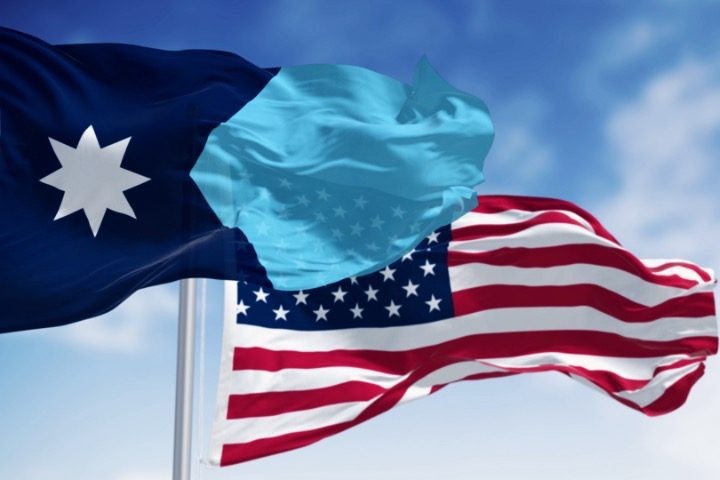
Presumptive vice-presidential nominee Tim Walz (D-Minn.) might’ve fiddled while Minneapolis burned and skedaddled when Iraq duty called, but he sure didn’t waver when it came to fighting a woke battle: changing his state’s supposedly non-inclusive flag.
Four-star General of Destroying History
In fact, while Walz might’ve never been the “Command Sergeant Major” he’s claimed to be for political gain, he sure is the four-star general of destroying history, say critics.
As PragerU director Jill Simonian wrote Wednesday at Fox News:
Earlier this year, Minnesota scrapped its historical state flag and replaced it with a new, more “inclusive” one. “Our [previous] flag is problematic,” said vice president hopeful and current Minnesota Governor Tim Walz, who…[helped enable] an expedited, 17-person commission to remove an image of a farmer and a Native American from the flag and replace it with an eight-point starburst often associated with a Babylonian goddess named Ishtar. Despite about half of Minnesotans reportedly disagreeing with the switch, they had little say in the matter. The commission reportedly changed the state flag without giving constituents an opportunity to vote.
… When I found out that a small group of individuals changed a historical state flag without the consent of the people of Minnesota, I was outraged.
As an Armenian-American mom, I also can’t help but recognize that Minnesota’s newly featured eight-point star is identical to the star on the Ottoman Empire’s flag during the late 1800s — the flag that was active when Islamic Ottoman Turks began committing genocide on Christian Armenians in the area. Another flag that touts this same eight-point star? Azerbaijan — whose military ethnically cleansed indigenous Armenians in Nagorno-Karabakh as recently as 2023.
While the new banner’s defenders claim that any resemblance to an Ottoman or Somalian flag (the latter is also alleged) is purely coincidental — and this may be true — there’s no doubt that wokesters were upset about the traditional flag’s imagery. The banner’s portrayal of a white farmer tending his land while an American Indian on horseback passes behind him is, some say, a depiction of the “native inhabitants’” displacement by “European colonizers.” But is it?
The Traditional Flag
Consider what WorldAtlas explains about the traditional Minnesota flag’s meaning:
The design is in a field of blue with the image of the seal in the middle. The seal is surrounded by a white banner forming an outer circle with 19 stars distributed all-round the circle. These stars symbolize the states of the US with Minnesota being the nineteenth state to join the union. On the upper part is the largest star which denotes the North Star and the state of Minnesota. The stars are symbols of being outstanding states.
The images on the seal are a man plowing and an indigenous American Indian on horseback holding an axe and a gun. Images symbolize the rich agricultural potential, the landscape, and the heritage of the early inhabitants. On the background of the seal is a river depicting the importance of Rivers Mississippi and St Anthony to the state. The state tree is captured by the three pine trees on the background. The trees symbolize the timber-rich regions of St. Croix and Lake Superior. The seal is surrounded by the pink lady flower which is the official state flower.
In addition, not only is there no indication that the flag’s 19th-century creator, Amelia Hyde Center, was any kind of bigot, there’s also speculation her design was inspired by the flags of Minnesota military regiments that fought for the Union in the War Between the States. A short video on the flag’s history and development follows.
And below is a video presenting the new flag.
In fairness and as I reported in February 2023, there had been a long-standing effort to replace the traditional flag. And this effort’s proponents had cited some very mundane reasons for doing so (e.g., the old banner was too complex). The problem?
Part of the Culture War
Woke thought police such as Walz — and state Representative Mike Freiberg, who sponsored a bill to change the flag — cited politically correct reasons. For example, Freiberg claimed the banner was racist, stating, “It has a very clear connotation.”
Others say he and his fellow travelers have a very clear agenda. Simonian asserts, for instance, that the new flag represents the erasure of history and, in particular, of Indian culture. An Indian-descent Minnesotan she cites, Donna Bergstrom, does say, too, that the change is an “assault” on her heritage.
It’s an assault on far more than that, however. While leftists will often fight to eliminate long-present Indian symbols and imagery, they also do things such as rename Mount McKinley “Denali” (an Indian word). Enemies of the status quo and Year Zero enablers, they always seek to replace “what is” with, very often, “what shouldn’t be” (that is, until they control “what is”).
So what’s actually occurring is a cultural revolution, what Simonian calls a sort of “coup d’etat.” This is the real reason to oppose efforts such as the Minnesota flag change: Far from being isolated incidents, they are fronts in a culture war. It’s statues coming down here, there, and everywhere; buildings renamed; words redefined; traditions overturned; culture upended; and morals obliterated.
So as with any war, it’s not about the small piece of territory one enemy battalion wants at the moment. Relinquishing it won’t appease them. It’s about the territory they’re claiming continually, incrementally, as they author their victory by a thousand cuts.
The end result is that you may wake up one day realizing that before you can even begin to make America great again, you must make America America again. Win the battles or lose the war.



